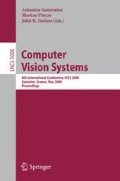Abstract
In this paper we present a framework for detecting and recognizing abandoned objects in crowded environments. The two main components of the framework include background change detection and object recognition. Moving blocks are detected using dynamic thresholding of spatiotemporal texture changes. The background change detection is based on analyzing wavelet transform coefficients of non-overlapping and non-moving 3D texture blocks. Detected changed background becomes the region of interest which is scanned to recognize various objects under surveillance such as abandoned luggage. The object recognition is based on model histogram ratios of image gradient magnitude patches. Supervised learning of the objects is performed by support vector machine. Experimental results are demonstrated using various benchmark video sequences (PETS, CAVIAR, i-Lids) and an object category dataset (CalTech256).
Access this chapter
Tax calculation will be finalised at checkout
Purchases are for personal use only
Preview
Unable to display preview. Download preview PDF.
References
Cheung, S.-C.S., Kamath, C.: Robust background subtraction with foreground validation for urban traffic video. EURASIP J. Appl. Signal Process. 2005(1), 2330–2340 (2005)
Hall, D., Nascimento, J., Ribeiro, P., Andrade, E., Moreno, P., Pesnel, S., List, T., Emonet, R., Fisher, R.B., Victor, J.S., Crowley, J.L.: Comparison of target detection algorithms using adaptive background models. In: ICCCN 2005: Proceedings of the 14th International Conference on Computer Communications and Networks, Washington, DC, USA, pp. 113–120. IEEE Computer Society Press, Los Alamitos (2005)
Piccardi, M.: Background subtraction techniques: a review. In: Proceedings of the IEEE International Conference on Systems, Man and Cybernetics, vol. 4, pp. 3099–3104 (2004)
Tian, Y.-L., Lu, M., Hampapur, A.: Robust and efficient foreground analysis for real-time video surveillance. In: Proc. IEEE Conf. on Computer Vision and Pattern Recognition, vol. 1, pp. 1182–1187 (2005)
Oliver, N.M., Rosario, B., Pentland, A.P.: A bayesian computer vision system for modeling human interactions. IEEE Trans. Pattern Anal. Mach. Intell. 22(8), 831–843 (2000)
Stauffer, C., Grimson, W.E.L.: Adaptive background mixture models for real-time tracking. In: Proc. IEEE Conf. on Computer Vision and Pattern Recognition, vol. 2, pp. 246–252 (1999)
Grabner, H., Roth, P.M., Grabner, M., Bischof, H.: Autonomous learning of a robust background model for change detection. In: Proceedings 9th IEEE International Workshop on PETS (2006)
Lowe, D.G.: Distinctive image features from scale-invariant keypoints. IJCV 60(2), 91–110 (2004)
Mikolajczyk, K., Schmid, C.: Scale and affine invariant interest point detectors. IJCV 60(1), 63–86 (2004)
Lazebnik, S., Schmid, C., Ponce, J.: Beyond bags of features: Spatial pyramid matching for recognizing natural scene categories. In: IEEE Conference on Computer Vision and Pattern Recognition, pp. 2169–2178 (2006)
Latecki, L.J., Miezianko, R., Pokrajac, D.: Motion detection based on local variation of spatiotemporal texture. In: 2004 Conference on Computer Vision and Pattern Recognition Workshop, vol. 8, pp. 135–141 (2004)
Griffin, G., Holub, A., Perona, P.: Caltech-256 object category dataset. Technical Report 7694, California Institute of Technology (2007)
Levi, K., Weiss, Y.: Learning object detection from a small number of examples: The importance of good features. In: IEEE Conference on Computer Vision and Pattern Recognition, pp. 53–60 (2004)
Latecki, L.J., Miezianko, R.: Object tracking with dynamic template update and occlusion detection. In: International Conference on Pattern Recognition, vol. 1, pp. 556–560 (2006)
PETS 2006: Performance Evaluation of Tracking and Surveillance 2006 Benchmark Data. http://www.cvg.rdg.ac.uk/PETS2006/
Viola, P., Jones, M.: Rapid object detection using a boosted cascade of simple features. In: CVPR, vol. 1, pp. 511–518 (2001)
PETS 2007: Performance Evaluation of Tracking and Surveillance 2007 Benchmark Data. http://www.cvg.rdg.ac.uk/PETS2007/
i Lids: i-Lids dataset for AVSS (2007), http://www.elec.qmul.ac.uk/staffinfo/an-drea/avss2007.html
CAVIAR: EC Funded CAVIAR project/IST 2001 37540. http://homepages.inf.ed.ac.uk/rbf/CAVIAR/
Author information
Authors and Affiliations
Editor information
Rights and permissions
Copyright information
© 2008 Springer-Verlag Berlin Heidelberg
About this paper
Cite this paper
Miezianko, R., Pokrajac, D. (2008). Detecting and Recognizing Abandoned Objects in Crowded Environments. In: Gasteratos, A., Vincze, M., Tsotsos, J.K. (eds) Computer Vision Systems. ICVS 2008. Lecture Notes in Computer Science, vol 5008. Springer, Berlin, Heidelberg. https://doi.org/10.1007/978-3-540-79547-6_23
Download citation
DOI: https://doi.org/10.1007/978-3-540-79547-6_23
Publisher Name: Springer, Berlin, Heidelberg
Print ISBN: 978-3-540-79546-9
Online ISBN: 978-3-540-79547-6
eBook Packages: Computer ScienceComputer Science (R0)

